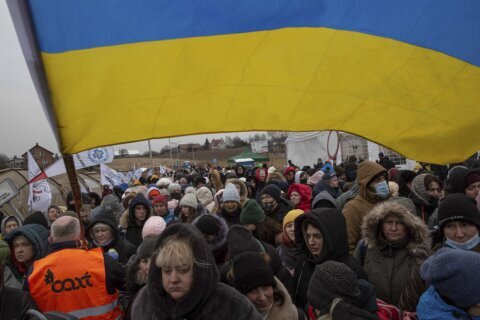KYIV, Ukraine (AP) — An explosion ripped through the Russian-controlled Olenivka prison barracks two years ago, killing more than 50 Ukrainian prisoners of war and leaving dozens injured.
The Associated Press interviewed over a dozen survivors, investigators and families of the dead and estimated 120 missing still being held captive. All described evidence they believe points directly to Russia as the culprit. The AP also obtained an internal United Nations analysis that found the same. Russia accused Ukraine of striking its own men with U.S.-supplied missiles.
Of the 193 Ukrainians in the barracks, less than two dozen made it back home. More than 50 died the night of July 29, 2022.
Here’s what to know from AP’s reporting:
Russia’s strange behavior
On the morning of July 27, 2022, Russian guards rounded up a group of prisoners and led them to an industrial section of the colony, away from the other five POW barracks. They were taken to a cinder-block building with a tin-plate roof with 100 bunks, no mattresses and hastily dug pit toilet, multiple survivors told AP.
That day, the guards dug trenches for themselves. The next day, they moved the guard post and put on bulletproof vest and helmets which they had not done before and unlike other Olenivka personnel.
When the explosion struck overnight, fire tore through the building. One witness recalled the guards stood there laughing, tossing rags and flashlights at the panicked Ukrainians.
Survivors were isolated beginning the next day from the rest of the POWs in the camp.
The internal U.N. analysis said their isolation was intended to prevent survivors speaking to others in the colony about what happened that night because some prisoners had access to mobile phones and had direct contact with Ukraine. It also left them unaware that Russia and Ukraine were trading blame as a U.N. Security Council meeting loomed.
The aftermath
According to the U.N. analysis, other Ukrainian prisoners were sent to the bombed barracks and ordered to remove debris and the remaining bodies. Two hours later, that group was sent into a nearby hangar, and some saw men in camouflage bringing boxes of ammunition to the blast site and set HIMARS fragments on a blue bench nearby.
Russian officials soon arrived, accompanied by Russian journalists whose images of twisted, charred bunk beds, HIMARS fragments and bodies laid out in the sun spread across the world.
The Ukrainians in the nearby hangar said after everyone was gone, the men in camouflage returned everything to the boxes and left.
A private and a public UN investigation
The U.N. secretary general announced it would conduct its own investigation, but negotiations to access the site were long and ultimately fruitless. The mission was disbanded on Jan. 5, 2023, having never traveled to Ukraine.
The separate Human Rights Monitoring Mission in Ukraine, which had been based in the country since Russia’s first invasion of Ukraine in 2014, didn’t wait. The team combed through testimonies on Russian television from 16 survivors taken to the hospital, examined public images from the site and analyzed 20 statements made by Russian officials who visited the prison.
Their conclusion: Russia planned and executed the attack.
Some of the evidence was incorporated piecemeal into broader U.N. reports on the war. One eventually concluded that the attack came from east to west. Russian territory lies east of occupied Donetsk. But the U.N. stopped short of blaming Russia publicly.
Fading hope for justice
There are no more active international investigations into the attack and a Ukrainian inquiry is one of tens of thousands of war crimes for investigators there. That raises wider questions about whether those who committed crimes in occupied areas can ever face justice.
A Ukrainian investigation is ongoing, according to Taras Semkiv of the Ukrainian prosecutor general’s war crimes unit. The challenge now is to identify the weapon used, in hopes that could lead to who ordered the attack. Semkiv said the investigation has narrowed it to three possibilities — artillery, planted explosives, or a grenade launcher.
Semkiv said no international investigators have requested information from the General Prosecutor’s Office since the deaths at Olenivka, including the disbanded U.N. fact-finding mission. He said initial optimism about the mission faded as soon as it became clear that they would not investigate at all if there was no access to the prison.
Relatives of those missing from the bombed barracks say they’re now alone in their search for answers.
Copyright © 2024 The Associated Press. All rights reserved. This material may not be published, broadcast, written or redistributed.







